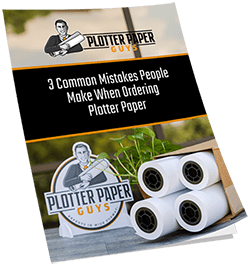Working out which paper size is going to be right for your project can be a challenge! Whether you wish to use paper for a technical project or an artistic project, being aware of the various paper sizes on the market can make life easier. To help, we’ve put together details of the various types and sizes of CAD drawing paper that are available for purchase. Read on to discover engineering drawing paper sizes, as well as the art drawing paper sizes that are currently offered.
Sheets or Rolls?
In the first instance, it’s helpful to consider whether sheets of paper are required, or whether there is a need for paper that’s longer or wider than a standard sheet of paper.
Aside from customized paper, which is manufactured to the customer’s exact specification, paper can either be bought in sheets or in rolls.
For convenience, sheets are sold in standard sizes. This ensures that customers end up with the same size paper, regardless of where it’s sourced from. A standardized paper size ensures compatibility with almost any printer that has a sheet-fed capability, as well as enabling customers to use the paper size name (Arch C, Arch D, etc.) as a convenient method of describing the dimensions of the paper that they need.
The specific sizes of paper depend on whether sheets or rolls are needed. Sheets have a specific set of predetermined dimensions. In contrast, rolls are available in a wide selection of widths and lengths. Rolls are the main form of paper used to supply plotters or their modern equivalent, wide-format printers.
CAD Drawing Paper Sizes – the Roll and the Finished Print
When considering CAD drawing paper sizes, there are two distinct sets of measurements to look at. In the first instance, the wide-format printer will be supplied with a roll of paper, so that designs of varying lengths can be produced in one, continuous piece.
Once the design has finished printing, it will need to be cut from the roll to create a single piece of paper, which will have its own, specific dimensions. End users buy the printer rolls of paper, print on the roll, then cut the finished print to the correct sizes.
It’s not just the dimensions of paper that can vary, paper also comes in several different weights. In general, the heavier the paper is, the thicker it’s going to be. The most common weights for paper are 20lb (75gsm), 24lb (90gsm), and 28lb (105gsm). Specialty sheet or roll plotter paper may weigh as little as 13lb (49gsm) or as much as 46lb (151gsm).
Various Core Sizes Also Available
Depending on the type of printer being used, there are a number of different core options.
- A 2″ core is used where inkjet technology is being deployed. Some sizes available are 24″ x 150′, 30″ x 300′ and 36″ x 100′.
- A 3″ core is used when engineering copiers (xerographic technologies) are utilized. Commonly used sizes are 24″ x 500′, 30″ x 500′, and 36″ x 500′.
ISO 216, ANSI, and ASME
Although ISO 216 is commonly used to determine CAD drawing paper sizes across Europe and other MEDCs, Canada and the US haven’t adopted it. For CAD drawing paper, sizes are determined by ANSI (the American National Standards Institute) and ASME (the American Society for Mechanical Engineers).
The ANSI/ASME Paper Sizes (Engineering Drawing Paper Sizes)
- ANSI A 216 x 279mm (8.5” x 11”)
- ANSI B 432 x 279 mm (11” x 17”)
- ANSI C 432 x 559mm (17” x 22”)
- ANSI D 559 x 864mm (22” x 34”)
- ANSI E 864 x 1118mm (34” x 44”)
*Please note that these are NOT the same sizes as the drawing paper sizes used for architectural drawings.
Architectural Drawing Sheet Sizes
- Arch A 229 x 305mm (9″ x 12″)
- Arch B 305 x 457mm (12″ x 18″)
- Arch C 457 x 610mm (18″ x 24″)
- Arch D 610 x 914mm (24″ x 36″)
- Arch E 914 x 1219mm (36″ x 48″)
- Arch F 1762 x 1067mm (30″ x 42″).
What is 24″ x 36″ Paper Called?
As indicated above, the dimensions 24″ x 36″ correspond to the “Arch D” architectural drawing size. 30″ x 42″ paper size would correspond to Arch F. Architectural paper sizes are also used for art drawing paper sizes. For clarity, we have given the art drawing paper sizes in inches and millimetres. The Arch sizing defines the size of paper that plans are printed on. The ANSI sizing is used for printing out blueprints.
What are the Four Standard Paper Sizes?
As already indicated, there are a number of different paper sizes used for technical drawing, paper drafting and artistic work.
The most commonly used standard paper sizes are:
- Letter-size (8½” x 11″/216x279mm/ANSI A). This size roughly equates to the ISO 216 A4 size, but not exactly so. A4 size drawing paper measures 8¼” x 11¾” (21cm x 29.7cm).
- Tabloid size (11″ x 17″ /279 x 432mm/ANSI B)
- Legal size (8½” x 14″ / 216 x 102mm/ no ANSI equivalent)
- Ledger size 17″ x 11″/432mm x 279mm/ANSI B)
Which is the big Size of the Drawing Sheet?
The biggest size of drawing sheet will vary, depending on whether the drawing is to be used for engineering or architectural purposes. For engineering, the largest dimensions would be ANSI K (1016 x 3632mm). For architectural drawings, the largest dimensions would be Arch F (1762 x 1067).
Note that not all countries use these standard measurements for their CAD drawing paper sizes – in the Philippines, for example, blueprints are commonly printed onto sheets that measure 20″ x 30″. If you’re not sure about any aspect of your paper sizing, please talk to the Plotter Paper Guys. We have in-depth knowledge of all aspects of paper sizing and will be happy to advise. Get in touch to discuss your requirements in more detail.




